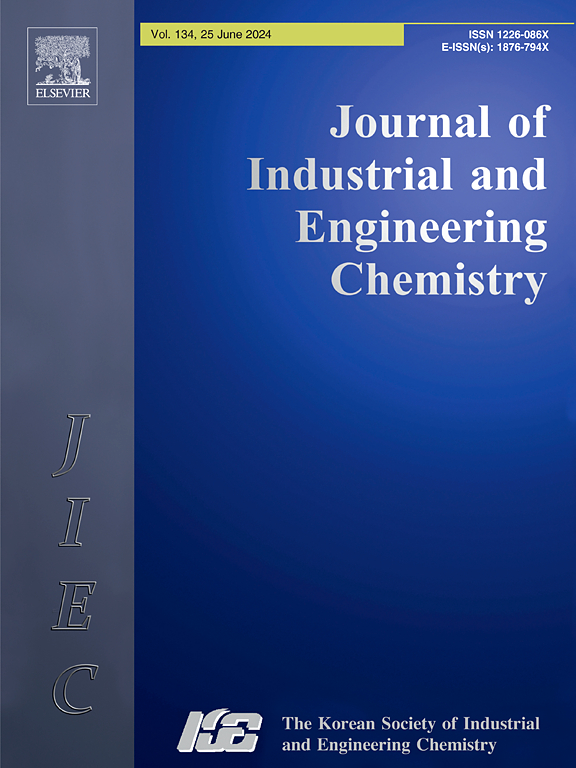通过氟化碳(CFX)复合分离器设计用于稳定锂金属电池的富liff固体电解质间相层
IF 5.9
3区 工程技术
Q1 CHEMISTRY, MULTIDISCIPLINARY
Journal of Industrial and Engineering Chemistry
Pub Date : 2024-12-03
DOI:10.1016/j.jiec.2024.12.002
引用次数: 0
摘要
形成稳定的固体电解质界面层对于提高锂金属电池的循环稳定性和安全性至关重要。然而,由于锂金属阳极(LMAs)的反应性非常高,控制锂离子在阳极/电解质界面的运动仍然是一个挑战。在这项研究中,提出了一种将氟功能控制的氟化碳(CFX)层涂覆在商用PE分离器上以形成稳定的SEI层的方法。组成CFX的氟官能团与Li+之间的强烈反应促进了在静息和初始循环阶段快速形成富liff的SEI层。这一初始稳定的SEI层促进了随后均匀的Li+通量,从而提高了LMA的稳定性。此外,利用氟总量和氟官能团通过氟控制官能团的cfx包覆PE隔板控制Li+动力学的机理,确定了氟总量和氟官能团提供稳定SEI层形成优势的机理。因此,本研究通过解决与lma相关的循环稳定性问题,为储能领域做出贡献,并强调根据氟官能团的类型,通过重要的界面控制,可以形成稳定的SEI层。本文章由计算机程序翻译,如有差异,请以英文原文为准。

Design of a LiF-rich solid electrolyte interphase layer through a fluorinated carbon (CFX) complex separator for stable lithium metal batteries
The formation of a stable solid electrolyte interphase (SEI) layer is very important for improving the cycling stability and safety of lithium metal batteries (LMBs). However, since the reactivity of lithium metal anodes (LMAs) is very high, controlling the movement of Li+ at the anode/electrolyte interface remains challenging. In this study, an approach involving coating a fluorine functional-controlled fluorinated carbon (CFX) layer onto a commercial PE separator to form a stable SEI layer was proposed. The strong reaction between the fluorine functional groups constituting CFX and Li+ facilitated the rapid formation of a LiF-rich SEI layer in the resting and initial cycling stages. This initial stable SEI layer promoted a subsequent homogeneous Li+ flux, thus improving the LMA stability. In addition, the mechanism by which the total amount of fluorine and the fluorine functional groups control the Li+ dynamics through the CFX-coated PE separator with controlled fluorine functional groups was used to identify the mechanism by which the total amount of fluorine and the fluorine functional groups provide the advantage of the creation of a stable SEI layer. Therefore, this study contributes to the energy storage field by solving the cycling stability problem related to LMAs and emphasizes that a stable SEI layer can be formed based on the important interface control according to the type of fluorine functional group.
求助全文
通过发布文献求助,成功后即可免费获取论文全文。
去求助
来源期刊
CiteScore
10.40
自引率
6.60%
发文量
639
审稿时长
29 days
期刊介绍:
Journal of Industrial and Engineering Chemistry is published monthly in English by the Korean Society of Industrial and Engineering Chemistry. JIEC brings together multidisciplinary interests in one journal and is to disseminate information on all aspects of research and development in industrial and engineering chemistry. Contributions in the form of research articles, short communications, notes and reviews are considered for publication. The editors welcome original contributions that have not been and are not to be published elsewhere. Instruction to authors and a manuscript submissions form are printed at the end of each issue. Bulk reprints of individual articles can be ordered. This publication is partially supported by Korea Research Foundation and the Korean Federation of Science and Technology Societies.

 求助内容:
求助内容: 应助结果提醒方式:
应助结果提醒方式:


